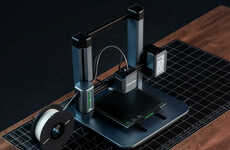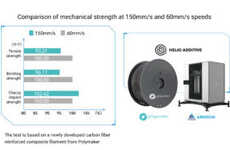
The 'Rose Go' 3D Printer Has a 300mm/s Travel Speed
Michael Hemsworth — October 16, 2019 — Tech
References: kickstarter & gadgetify
The 'Rose Go' 3D printer is a compact, accessible peripheral for makers who are looking for a better way to create their choice of project or product in an ultra-precise manner. The printer is engineered with a 300mm/s travel speed, auto leveling functionality and a 0.9-degree stepper motor that will work together to ensure the utmost attention to quality printing jobs.
The peripheral is outfitted with a crisp touchscreen for changing the settings and monitoring the progress, while an LED is positioned onto the printing area to illuminate jobs as they are created. The 'Rose Go' 3D printer is rounded off with a silent stepper motor driver that will keep sound below 10dB to make it suitable for use in open-concept offices or homes without causing a disturbance.
The peripheral is outfitted with a crisp touchscreen for changing the settings and monitoring the progress, while an LED is positioned onto the printing area to illuminate jobs as they are created. The 'Rose Go' 3D printer is rounded off with a silent stepper motor driver that will keep sound below 10dB to make it suitable for use in open-concept offices or homes without causing a disturbance.
Trend Themes
1. Ultra-precise 3D Printing - The advancement of ultra-precise 3D printing technology opens up opportunities for small-scale manufacturing with higher accuracy and quality.
2. Compact 3D Printers - The popularity of compact 3D printers suggests a shift towards a more accessible and user-friendly printing experience that can potentially increase adoption rates among hobbyist markets.
3. Silent 3D Printer Motors - Silent 3D printer motors allow for more versatile placement and usage in home, office, and other noise-sensitive environments.
Industry Implications
1. Manufacturing Industry - The ultra-precise 3D printing technology can significantly improve the precision and efficiency of the manufacturing industry.
2. Consumer Electronics Industry - With a rising demand for accessible 3D printing, the consumer electronics industry could capitalize on the market by producing more affordable and user-friendly 3D printers.
3. Architectural Industry - The ability for architects and designers to create accurate 3D models with ultra-precise 3D printers could revolutionize the industry by reducing time and costs for physical models.
6.3
Score
Popularity
Activity
Freshness























